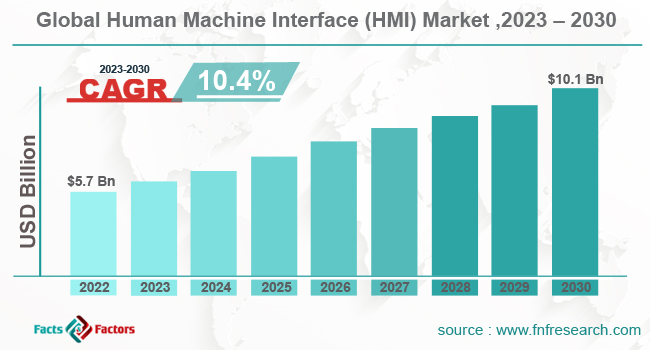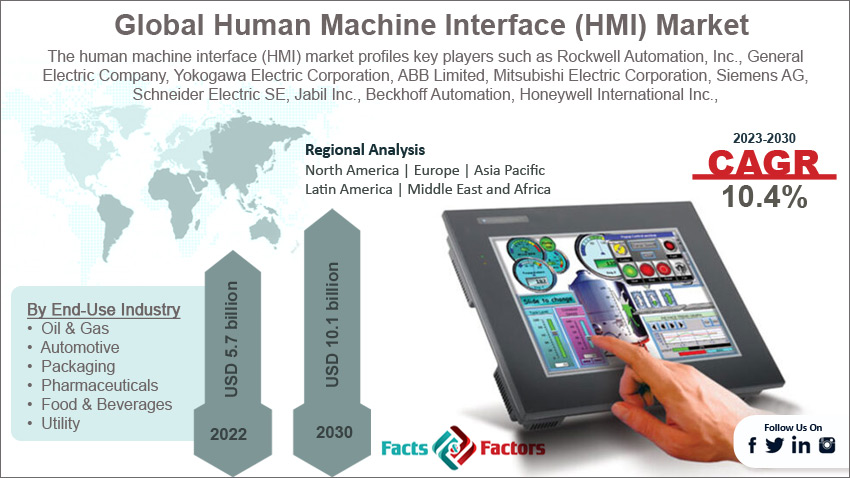Search Market Research Report
Human Machine Interface (HMI) Market Size, Share Global Analysis Report, 2023 – 2030

Human Machine Interface (HMI) Market Size, Share, Growth Analysis Report By Product (Hardware and Software), By Configuration (Embedded HMI and Standalone HMI), By End-Use Industry (Oil & Gas, Automotive, Packaging, Pharmaceuticals, Food & Beverages, and Utility), and By Region - Global and Regional Industry Insights, Overview, Comprehensive Analysis, Trends, Statistical Research, Market Intelligence, Historical Data and Forecast 2023 – 2030
Industry Insights
[210+ Pages Report] According to the report published by Facts & Factors, The global human machine interface (HMI) market size was evaluated at $5.7 billion in 2022 and is slated to hit $10.1 billion by the end of 2030 with a CAGR of nearly 10.4% between 2023 and 2030.

 Market Overview
Market Overview
Human Machine Interface is utilized as an operator control panel to RTU and PLC as well as IED. For the record, human machine interface also referred to as HMI replaces manually activated switches and dials as well as digital controls and other controls influencing processes.
Apart from this, HMI helps operators in commencing and halting cycles, adjusting set points, and performing various other operations needed in adjusting & interacting with process controls. Reportedly, the human machine interface is a key software app running on modern operating systems and capable of performing a slew of functions.
 Key Insights
Key Insights
- As per the analysis shared by our research analyst, the global human machine interface (HMI) market is projected to expand annually at the annual growth rate of around 10.4% over the forecast timespan (2023-2030)
- In terms of revenue, the global human machine interface market size was evaluated at nearly $5.7 billion in 2022 and is expected to reach $10.1 billion by 2030.
- The global human machine interface market is anticipated to record massive growth over the forecast period owing to surging demand for monitoring manufacturing units in a slew of sectors such as oil & gas, mining, and automotive.
- Based on the product, the software segment is predicted to contribute majorly towards the global market share over the forecast timeline.
- In terms of configuration, the embedded HMI segment is projected to record the highest CAGR over 2023-2030.
- Based on end-use industry, the automotive segment is slated to dominate the segmental surge over the forecast period.
- Region-wise, the Asia-Pacific human machine interface (HMI) market is projected to register the highest CAGR during the assessment period.

 Human Machine Interface (HMI)Market: Growth Factors
Human Machine Interface (HMI)Market: Growth Factors
- The need for monitoring the operations of production units of various industries will boost the global market size by 2030
An increase in industrial automation is predicted to enlarge the scope of growth of the global human machine interface (HMI) market. Surging demand for monitoring manufacturing units in a slew of sectors such as oil & gas, mining, and automotive will further boost the market expansion.
In addition to this, the launching of the industrial Internet of Things (IIOT) and HTML5 provides consumers with convenience and flexibility, thereby driving the global market space. Furthermore, strict laws pertaining to energy conservation, workplace safety, and an increase in labor costs will accentuate the global market expansion.
Apart from this, the rise in popularity of AR & VR systems and the demand for multi-touch screens will propel the global market demand. The need for improving productivity by minimizing startup time will steer the global market trends. An increase in the popularity of smart industrial solutions will embellish the business growth.
 Restraints
Restraints
- A rise in the initial installation costs will inhibit the global industry expansion
Huge deployment & maintenance costs of human machine interface systems can put brakes on the global human machine interface (HMI) industry expansion. Less availability of skilled professionals is also predicted to put brakes on the global industry surge.
 Opportunities
Opportunities
- An increase in the use of HMI in the automotive sector to open new growth avenues for the market across the globe
The thriving automotive industry and growing penetration of human-machine interface systems in small & medium organizations will open new growth opportunities for the global human-machine interface (HMI) market.
 Challenges
Challenges
- Growing probability of hacking cloud-based HMI can be a challenging task for the global industry surge
Growing safety issues and lack of standardization can be a challenging task for the global human—machine interface (HMI) industry. In addition to this, growing security risks related to cloud-based human machine interfaces will prove as the biggest challenge in the path of the global industry surge.
 Human Machine Interface (HMI)Market: Segmentation
Human Machine Interface (HMI)Market: Segmentation
The global human machine interface (HMI) market is sectored into the product, configuration, end-use industry, and region.
In terms of product, the global human machine interface market is sectored into hardware and software segments. Furthermore, the software segment, which accrued more than 45% of the global market share in 2022, is anticipated to retain its dominant status in the projected timeframe. The segmental growth in the forecasting years can be subject to the ability of HMI software in offering flexibility and reliability to production processes along with improving their efficacy.
Configuration-wise, the human machine interface industry across the globe is divided into embedded HMI and standalone HMI segments. Moreover, the embedded HMI segment, which gathered a major share of the global market in 2022, is forecast to register the fastest CAGR in the forecast timeframe. The growth of the segment over 2023-2030 can be owing to the ability of embedded HMI in providing an integrated and user-friendly environment to its end-users. In addition to this, technological breakthroughs and the need for integrated services will proliferate the segmental surge.
On the basis of the end-use industry, the global human machine interface market is divided into oil & gas, automotive, packaging, pharmaceuticals, food & beverages, and utility segments. Moreover, the automotive segment, which accumulated a major share of the global market in 2022, is forecast to dominate the end-use industry segment over the forecast timeframe. The growth of the segment over 2023-2030 can be owing to escalating demand for automobiles in emerging economies and technological breakthroughs witnessed in the automotive sector leading to the production of electric vehicles.
 Recent Breakthroughs:
Recent Breakthroughs:
- In the second half of 2019, ABB Limited, a Swiss-based firm, introduced a new kind of human-machine interface software integrated with a new visual control graphic interface. The move is predicted to boost the expansion of the human-machine interface (HMI) market in the years ahead.
- In the third quarter of 2019, Blackberry Limited, a software firm, and DENSO Corporation, a key automotive part manufacturer based in Japan, joined hands with SUBARU for launching integrated human machine interface digital cockpit tool and Blackberry QNX systems that enable control of human-machine interface tool in vehicles. The strategic initiative will embellish the growth of the global industry.
- In the first half of 2019, Siemens, the largest industrial manufacturing firm, launched a new version of human-machine interface software. The initiative will embellish the business landscape.
 Report Scope
Report Scope
Report Attribute |
Details |
Market Size in 2022 |
USD 5.7 Billion |
Projected Market Size in 2030 |
USD 10.1 Billion |
CAGR Growth Rate |
10.4% CAGR |
Base Year |
2022 |
Forecast Years |
2023-2030 |
Key Market Players |
Rockwell Automation Inc., General Electric Company, Yokogawa Electric Corporation, ABB Limited, Mitsubishi Electric Corporation, Siemens AG, Schneider Electric SE, Jabil Inc., Beckhoff Automation, Honeywell International Inc., Omron Corporation, Emerson Electric Co., Advantech Co. Ltd., Exor International, Eaton Corporation., and others. |
Key Segment |
By Product, Configuration, End-Use Industry and Region |
Major Regions Covered |
North America, Europe, Asia Pacific, Latin America, and the Middle East &, Africa |
Purchase Options |
Request customized purchase options to meet your research needs. Explore purchase options |
 Human Machine Interface (HMI)Market: Regional Insights
Human Machine Interface (HMI)Market: Regional Insights
- North American Human Machine Interface (HMI) market to establish a dominant status over the forecast timeline
North America, which garnered more than half of the global human-machine interface (HMI) market revenue in 2022, is anticipated to record humungous growth during the projected timeline. The regional market expansion over 2023-2030 can be subject to an increase in the presence of a huge number of service providers in the countries such as Canada and the U.S. Easy acceptance of new technologies in North America will help the region garner a major share of the global market.
Furthermore, human-machine interface (HMI) industry in the Asia-Pacific zone is predicted to record the highest CAGR in the anticipated timeframe. The factors that are likely to impact the growth of the regional industry are an increase in population and a rise in the demand for HMI tools in countries such as Japan and China. Rapid industrialization is set to boost the expansion of the industry in the Asia-Pacific zone. Easy access to low-cost labor and raw materials will push up the growth of the regional market.
 Competitive Space
Competitive Space
- Rockwell Automation Inc.
- General Electric Company
- Yokogawa Electric Corporation
- ABB Limited
- Mitsubishi Electric Corporation
- Siemens AG
- Schneider Electric SE
- Jabil Inc.
- Beckhoff Automation
- Honeywell International Inc.
- Omron Corporation
- Emerson Electric Co.
- Advantech Co. Ltd.
- Exor International
- Eaton Corporation.
The global human machine interface (HMI) market is segmented as follows:
 By Product Segment Analysis
By Product Segment Analysis
- Hardware
- Software
 By Configuration Segment Analysis
By Configuration Segment Analysis
- Embedded HMI
- Standalone HMI
 By End-Use Industry Segment Analysis
By End-Use Industry Segment Analysis
- Oil & Gas
- Automotive
- Packaging
- Pharmaceuticals
- Food & Beverages
- Utility
 By Regional Segment Analysis
By Regional Segment Analysis
- North America
- The U.S.
- Canada
- Mexico
- Europe
- France
- The UK
- Spain
- Germany
- Italy
- Rest of Europe
- Asia Pacific
- China
- Japan
- India
- Australia
- Southeast Asia
- Rest of Asia Pacific
- The Middle East & Africa
- Saudi Arabia
- UAE
- Egypt
- Kuwait
- South Africa
- Rest of the Middle East & Africa
- Latin America
- Brazil
- Argentina
- Rest of Latin America
Industry Major Market Players
- Rockwell Automation Inc.
- General Electric Company
- Yokogawa Electric Corporation
- ABB Limited
- Mitsubishi Electric Corporation
- Siemens AG
- Schneider Electric SE
- Jabil Inc.
- Beckhoff Automation
- Honeywell International Inc.
- Omron Corporation
- Emerson Electric Co.
- Advantech Co. Ltd.
- Exor International
- Eaton Corporation.
Frequently Asked Questions

Copyright © 2025 - 2026, All Rights Reserved, Facts and Factors


